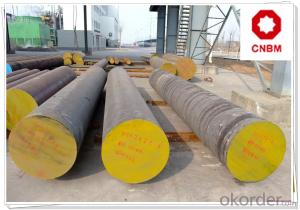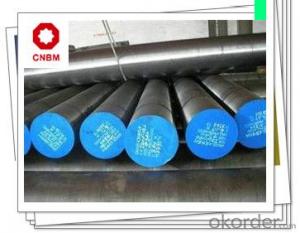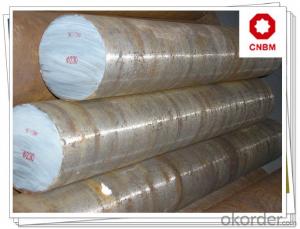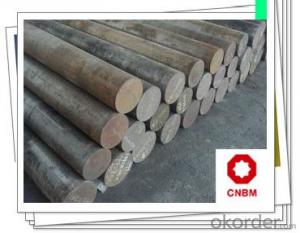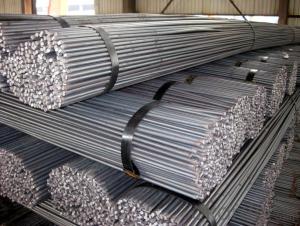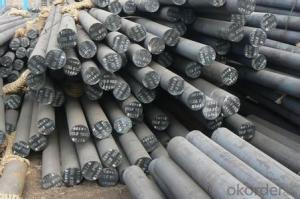Carbon Steel C30/C35/C40/C45/C50/C55/C58 Round Bars
- Loading Port:
- Shanghai
- Payment Terms:
- TT OR LC
- Min Order Qty:
- 30 m.t.
- Supply Capability:
- 120000 m.t./month
OKorder Service Pledge
OKorder Financial Service
You Might Also Like
Low Carbon Steel C10/C15/C22/C25 Round Bars
Product Description
1, Diameter: 8mm-250mm rounds
5mm-9mm rods
2, Length: 2m, 3m, 5.8m, 6m or customized
3, Standard: GB, ASTM, AISI, SAE, DIN, JIS, EN
OEM technology - send detailed technical parameters for accurate quotation.
2, Produce Process: smelt iron - EAF smelt billet - ESR smelt billet -
hot rolled or forged to get the steel round bar and plate
3, Heat Treatment: annealing, normalizing, tempering, quenching
4, Surface Treatment: Black, Polished, Galvanized
5, Quality Assurance: We accept third party inspection for all orders.
You can ask testing organizations such as SGS, BV, etc. to test our products before shipping.
Products Show
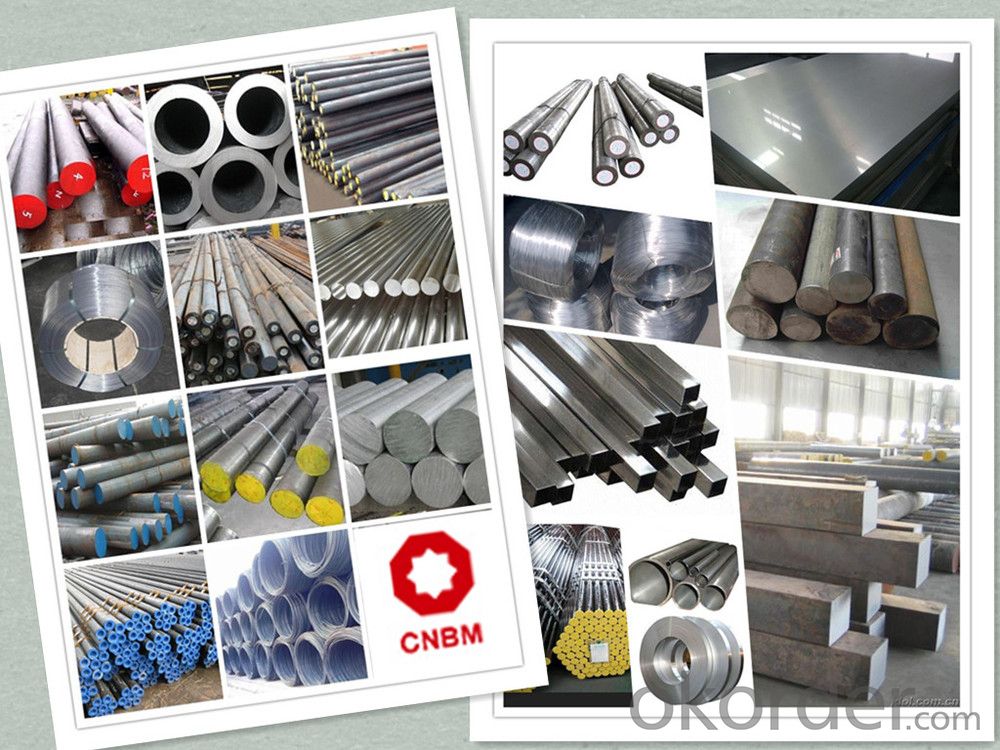
Product Overviews
| Product Name | Typical Grades | Diameter(mm) | Standard adopted |
| Carbon Steel | 20 (1020/S20C/C22) | Ø16-Ø300 |
GB/SAE/JIS/DIN
|
| 40 (1040/S40C/C40) | |||
| 45 (1045/S45C/C45) | |||
| Bearing Steel | GCr9 (51100/SUJ1) | Ø12-Ø250 | |
| GCr15 (52100/SUJ2/100Gr6) | |||
| GCr9SiMn (A485-Gr.1/SUJ3) | |||
Cr-Mo Steel | 20Cr (5120/SCr420H/20Cr4) | Ø12-Ø250 | |
| 40Cr (5140/SCr440/41Cr4) | |||
| 42CrMo(4140/SCM440/42CrMo4) | |||
| Gear Steel | 20CrNiMo | Ø16-Ø600 | |
| 20CrMn(5115/SMnC420/20MnCr5) | |||
| 20CrNiMo(8620/SNCM220/20CrMiMo2) |
Work Shop

Company Information
CNBM International Corporation is the most important trading platform of CNBM group.
Whith its advantages, CNBM International are mainly concentrate on Cement, Glass, Iron and Steel, Ceramics industries and devotes herself for supplying high qulity series of refractories as well as technical consultancies and logistics solutions.

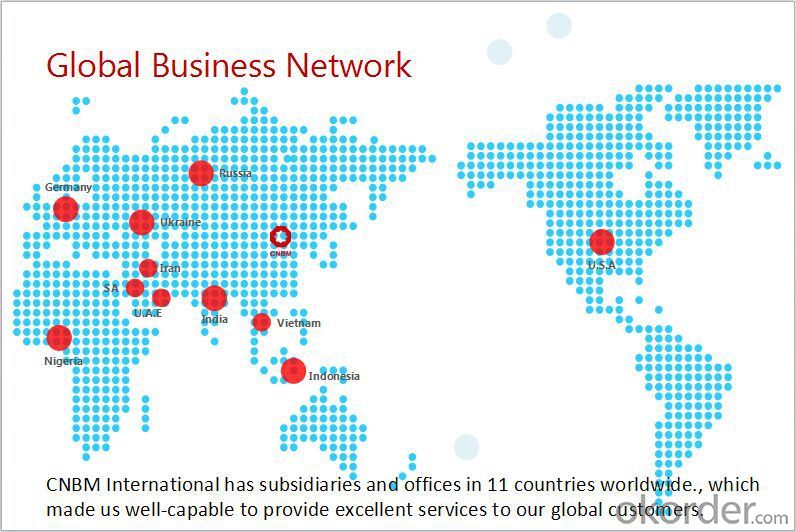
FAQ
1, Your advantages?
professional products inquiry, products knowledge train (for agents), smooth goods delivery, excellent customer solution proposale
2, Test & Certificate?
SGS test is available, customer inspection before shipping is welcome, third party inspection is no problem
3, Factory or Trading Company?
CNBM is a trading company but we have so many protocol factories and CNBM works as a trading department of these factories. Also CNBM is the holding company of many factories.
4, Payment Terms?
30% TT as deposit and 70% before delivery.
Irrevocable L/C at sight.
5, Trading Terms?
EXW, FOB, CIF, FFR, CNF
6, After-sale Service?
CNBM provides the services and support you need for every step of our cooperation. We're the business partner you can trust.
For any problem, please kindly contact us at any your convenient time.
We'll reply you in our first priority within 24 hours.
Packaging & Delivery
1, Packaging: seaworthy package or as required
2, Delivery: 35-45 days or based on quantity
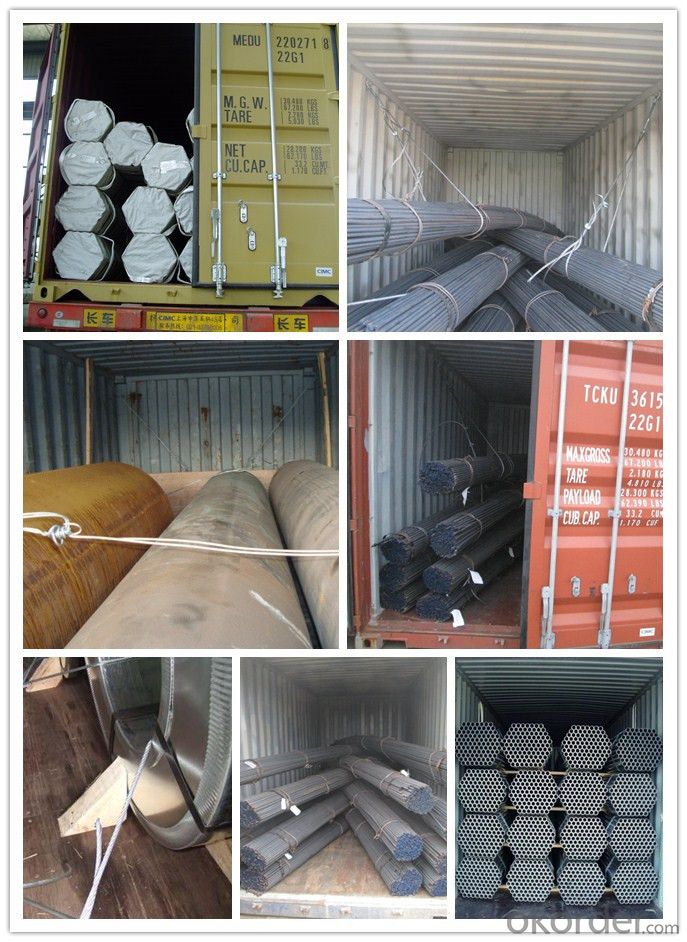
- Q:Can steel round bars be used in the manufacturing of consumer goods?
- Yes, steel round bars can be used in the manufacturing of consumer goods. Steel is a versatile and durable material that can be shaped into various forms, including round bars, to meet specific manufacturing requirements. These round bars can be utilized in the production of a wide range of consumer goods such as furniture, appliances, tools, and automotive components, among others.
- Q:How are steel round bars used in the manufacturing of hydraulic systems?
- Steel round bars are commonly used in the manufacturing of hydraulic systems due to their strength, durability, and versatility. These bars serve various purposes in the construction and assembly of hydraulic components. One primary use of steel round bars in hydraulic systems is for the fabrication of piston rods. Piston rods are crucial components of hydraulic cylinders, responsible for transferring the force generated by the hydraulic fluid to the desired mechanism. The high strength and rigidity of steel round bars make them ideal for this application, as they can withstand the intense pressure and stress exerted on the piston rod during operation. Steel round bars are also utilized in the manufacturing of shafts and axles within hydraulic systems. These components are responsible for transmitting rotational motion and torque from the hydraulic pump to other mechanical parts, such as gears or pulleys. By using steel round bars, manufacturers can ensure the reliability and longevity of these critical parts, as they possess excellent mechanical properties and resistance to wear and tear. Additionally, steel round bars are often employed in the construction of hydraulic fittings and connectors. These components are responsible for joining different hydraulic pipes, hoses, or valves together, creating a sealed system for fluid transmission. Steel round bars provide the necessary strength and stability to withstand the high-pressure conditions within hydraulic systems, ensuring leak-free operation and the efficient transfer of fluids. In summary, steel round bars play a vital role in the manufacturing of hydraulic systems by providing strength, durability, and versatility. Their use in piston rods, shafts, axles, fittings, and connectors ensures the proper functioning and reliability of these systems.
- Q:How do you calculate the weight of a steel round bar based on its density and dimensions?
- To calculate the weight of a steel round bar, you need to know its density and dimensions. The formula to calculate weight is W = V x D, where W represents weight, V represents volume, and D represents density. First, you need to find the volume of the round bar. The formula to calculate the volume of a cylinder is V = πr^2h, where V represents volume, π is a constant (approximately 3.14159), r represents the radius of the round bar, and h represents the height or length of the round bar. If you have the diameter of the round bar instead of the radius, you can divide the diameter by 2 to find the radius. Once you have the radius, you can substitute it into the formula along with the height of the round bar to calculate the volume. Next, you need to know the density of the steel. The density of steel is typically measured in grams per cubic centimeter (g/cm^3) or kilograms per cubic meter (kg/m^3). Make sure the units of both the density and volume are consistent. If the density is given in g/cm^3, convert the volume from cm^3 to m^3 by dividing it by 1,000,000. Finally, multiply the volume by the density to calculate the weight. If the density is in kg/m^3, the weight will be in kilograms. If the density is in g/cm^3, the weight will be in grams. You can convert the weight to other units by using appropriate conversion factors. Remember to double-check your calculations and ensure that all units are consistent throughout the calculation.
- Q:Are steel round bars suitable for welding?
- Yes, steel round bars are suitable for welding. Steel round bars are commonly used in welding applications due to their excellent strength and durability. They can be easily welded using various welding techniques such as MIG (Metal Inert Gas), TIG (Tungsten Inert Gas), or stick welding. However, it is important to choose the appropriate welding method and consumables based on the specific grade and alloy composition of the steel round bar to ensure a successful weld. Additionally, proper surface preparation and cleaning are crucial to achieve strong and reliable welds. Overall, steel round bars are a popular choice for welding projects due to their versatility and ability to withstand high temperatures and stress.
- Q:What is the difference between a hot-rolled and a ground steel round bar?
- A hot-rolled steel round bar is produced through a process called hot rolling, where the steel is heated above its recrystallization temperature and then passed through rollers to achieve the desired shape and size. This method results in a rough surface finish with a scaled or uneven texture. Hot-rolled steel round bars are commonly used in construction, manufacturing, and general fabrication applications where a smooth finish is not a primary concern. On the other hand, a ground steel round bar undergoes a process called grinding after the initial hot rolling. Grinding involves removing the outer layer of the hot-rolled bar to create a smooth and consistent surface finish. This process eliminates any imperfections, such as scale or unevenness, to provide a more precise and refined product. Ground steel round bars are often utilized in applications where a smooth surface finish is crucial, such as in machining, toolmaking, and precision engineering. In summary, the main difference between a hot-rolled and a ground steel round bar lies in the surface finish. Hot-rolled bars have a rough and uneven texture, while ground bars have a smooth and consistent surface. The choice between the two depends on the specific application and the desired level of surface finish required.
- Q:What is the maximum length of a steel round bar available?
- The maximum length of a steel round bar that is available can differ due to different factors, including manufacturing capabilities, transportation restrictions, and customer demands. Nonetheless, in general, steel round bars can be manufactured in lengths that span from a few feet to several meters. The precise maximum length will be influenced by the size and diameter of the round bar, as well as other logistical factors to take into account. It is crucial to seek guidance from steel suppliers or manufacturers to ascertain the maximum length that is available for a particular type and size of steel round bar.
- Q:What are the different marking methods for steel round bars?
- Steel round bars commonly use several marking methods to identify and provide information about the bars. These methods include stamping, laser marking, inkjet printing, etching, and color coding. Stamping involves using a machine to imprint alphanumeric characters, symbols, or logos onto the steel bar's surface. This method provides a durable and corrosion-resistant marking. Laser marking, on the other hand, uses a laser beam to engrave precise and high-quality information onto the bar. It allows for intricate designs, barcodes, and serial numbers and ensures permanent identification. Inkjet printing is a non-contact method that prints information using inkjet technology. It is commonly used for barcodes, QR codes, and other data matrix codes. This method is fast and efficient, with ink that adheres effectively to the steel surface. Etching is a chemical method that removes layers of the steel's surface using acid or other chemicals. It creates a visible mark and is often used for logos and identification numbers. Etching provides a permanent and easily readable marking. Color coding is a simple method that uses paint or colored coatings to mark different steel grades. Each color represents a specific attribute or characteristic. Color coding allows for quick and visual identification of the bars. These marking methods are essential in industries like construction, manufacturing, and engineering as they ensure proper identification, traceability, and quality control of steel round bars. The choice of method depends on factors such as permanence, visibility, and the specific information to be marked on the bars.
- Q:Are steel round bars resistant to chemicals or acids?
- Most chemicals and acids do not affect steel round bars, although the level of resistance varies depending on the specific steel type and the concentration and nature of the chemical or acid. Stainless steel round bars, on the other hand, have excellent resistance to corrosion and many types of acids. This makes them ideal for use in industries like chemical processing, food processing, and pharmaceuticals. However, it is worth noting that aggressive chemicals and acids, such as hydrochloric acid or sulfuric acid at high concentrations, can still cause corrosion or damage to steel round bars. In these instances, it is advisable to seek advice from experts or consult material compatibility charts to determine the most appropriate steel alloy for the intended application.
- Q:What are the different testing methods used for steel round bars?
- There are several testing methods used for steel round bars to ensure their quality and suitability for various applications. These methods include: 1. Visual Inspection: This is the initial step of testing, where the bars are visually examined for any visible defects, such as cracks, surface irregularities, or improper dimensions. 2. Dimensional checks: Steel round bars undergo dimensional checks to verify their diameter, length, and straightness. Precise measurements are essential to meet the specified requirements. 3. Ultrasonic Testing: Ultrasonic waves are passed through the round bars to detect internal defects, such as cracks, voids, or inclusions. This method helps identify potential weaknesses that may affect the structural integrity of the bars. 4. Magnetic Particle Inspection: This method uses a magnetic field and magnetic particles to detect surface and near-surface defects like cracks, seams, or laps. It is particularly useful in ferromagnetic materials such as steel. 5. Dye Penetrant Inspection: This technique involves applying a colored dye to the surface of the round bars and then wiping it off. The dye penetrates into any surface cracks or defects, making them visible under ultraviolet light. 6. Hardness Testing: This test measures the hardness of the steel round bars using methods like Rockwell or Brinell scales. It helps determine the material's ability to withstand external forces and ensures it meets the required hardness specifications. 7. Tensile Testing: Tensile strength testing is conducted to measure the maximum load a steel round bar can bear before it breaks. This test helps evaluate the material's strength and ductility. 8. Chemical Analysis: Chemical analysis is performed to determine the composition of the steel round bars, including the presence of elements like carbon, manganese, sulfur, phosphorus, and others. It ensures that the steel meets the required chemical composition standards. These testing methods are crucial in ensuring the quality, reliability, and compliance of steel round bars with industry standards and customer requirements. It is essential to perform a combination of these tests to ensure the overall quality and performance of the steel round bars in different applications.
- Q:Can steel round bars be used for making handrails?
- Yes, steel round bars can be commonly used for making handrails due to their durability and strength.
1. Manufacturer Overview |
|
|---|---|
| Location | |
| Year Established | |
| Annual Output Value | |
| Main Markets | |
| Company Certifications | |
2. Manufacturer Certificates |
|
|---|---|
| a) Certification Name | |
| Range | |
| Reference | |
| Validity Period | |
3. Manufacturer Capability |
|
|---|---|
| a)Trade Capacity | |
| Nearest Port | |
| Export Percentage | |
| No.of Employees in Trade Department | |
| Language Spoken: | |
| b)Factory Information | |
| Factory Size: | |
| No. of Production Lines | |
| Contract Manufacturing | |
| Product Price Range | |
Send your message to us
Carbon Steel C30/C35/C40/C45/C50/C55/C58 Round Bars
- Loading Port:
- Shanghai
- Payment Terms:
- TT OR LC
- Min Order Qty:
- 30 m.t.
- Supply Capability:
- 120000 m.t./month
OKorder Service Pledge
OKorder Financial Service
Similar products
New products
Hot products
Related keywords

